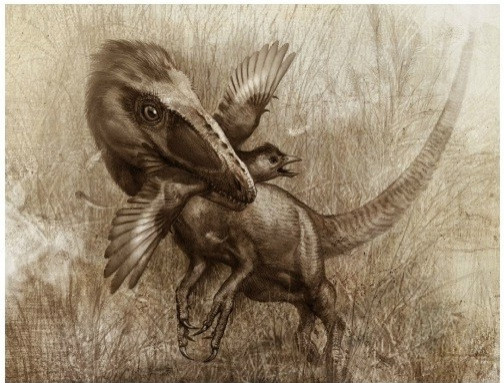Feathery Dinosaur Hunted Birds, Velociraptor Relatives

Turns out that one ground-dwelling dinosaur really liked to grab in-flight meals.
University of Alberta paleontologists, working with researchers from the Pipestone Creek Dinosaur Initiative in Alberta and the Chinese Academy of Geological Sciences, examined two skeletons of the extinct wolf-sized predator Sinocalliopteryx gigas. Sinocallipteryx, which lived about 124 million years ago, did not have wings but was coated with simple feathers that helped keep it warm.
Inside the two specimens, the researchers found remains from two kinds of flight-capable prey, according to a paper appearing Wednesday in the journal PLoS ONE.
One skeleton contained half-digested bits of three members of the Confuciusornis species, a very primitive bird about the size of a crow.
According to co-author and University of Alberta researcher Scott Persons, the feathery predator likely dispatched its airborne prey by stalking it.
"Sinocalliopteryx didn't have wings or the physical tools needed to be an adept tree climber," Persons said in a statement Wednesday.
The authors noted that nature is replete with present-day examples of land-bound predators successfully hunting flying prey. A number of wild felines including the tiny African black-footed cat, foxes, snakes and lizards hunt birds on the ground and in trees. Plus, the ancient fliers weren't as well-adapted for quick takeoff as modern birds, making them easier targets, the researchers said.
"The fact that this Sinocalliopteryx had, not one, but three undigested birds in its stomach indicate it was a voracious eater and a very active hunter," said Persons.
Another Sinocallipteryx specimen contained the remains of another last meal: bits of Sinornithosaurus, a house cat-sized dromaeosaurid dinosaur related to the Velociraptor. This is the first evidence of a raptor being eaten by another predator, according to Persons.
SOURCE: Xing et al. "Stomach Contents from two Large Early Cretaceous Compsognathids (Dinosauria: Theropoda) Demonstrate Feeding on Conuciusornithids and Dromaeosaurids." PLoS ONE 7: e44012, 29 August 2012.
© Copyright IBTimes 2024. All rights reserved.





















